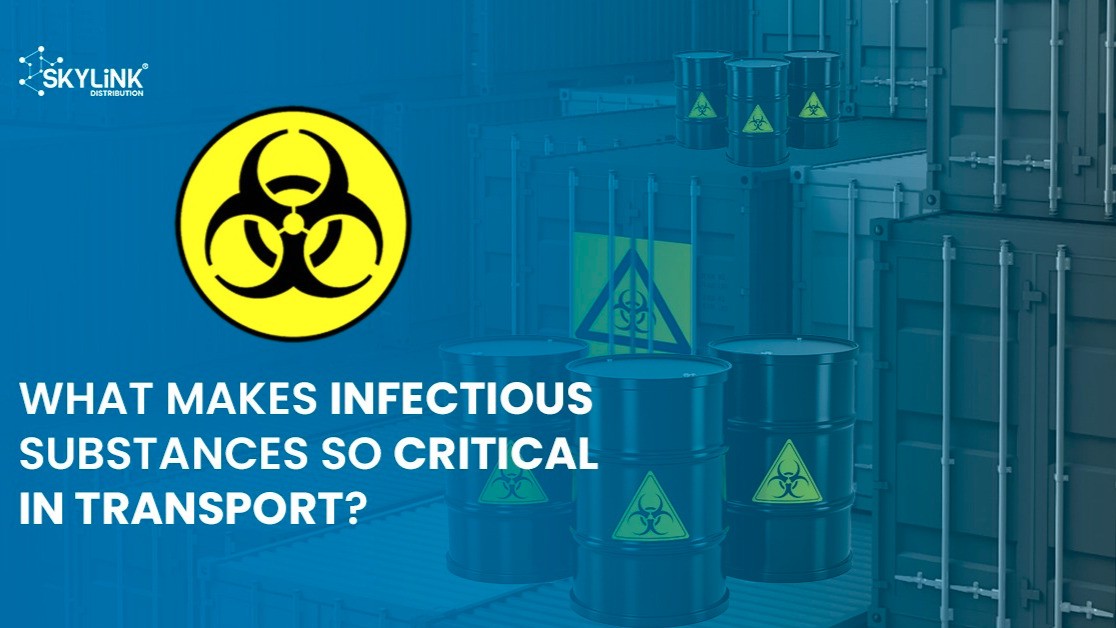What Makes Infectious Substances So Critical in Transport?

Infectious substances have a special and strictly controlled place in the shipping of hazardous products. These materials, which are frequently genetically modified microbes, laboratory cultures, or medical samples, must be handled with the utmost care to avoid endangering the environment or human health. However, what precisely is included in this category, and how are such delicate objects transported? Without all the complicated language, let's boil it down in a comprehensible manner.
---------------------------------------------------------------------------------------------------------
Understanding Infectious Substances
Materials that are known or believed to contain pathogens—bacteria, viruses, fungus, or parasites—that can infect humans or animals are known as infectious substances. They are strictly controlled to guarantee safe handling, packing, and transportation because they are classified as Class 6.2 hazardous materials.
Infectious substances are separated into two primary categories in order to distinguish their characteristics:
Category A Infectious Substances: When exposed to these compounds, people or animals may develop deadly infections, life-threatening disorders, or lifelong disabilities. Among the examples are:
Ebola virus
Anthrax
Rabies virus
Tuberculosis cultures
SARS-CoV-2 (severe cases)
UN2814 (affecting humans) and UN2900 (affecting animals) are the UN numbers for these.
Category B Infectious Substances – These are less dangerous, and exposure to them usually does not result in serious illnesses. They are given the UN number UN3373 and frequently consist of:
Routine blood samples for disease testing
Urine samples
Certain bacterial cultures
DNA/RNA samples for diagnostic purposes
---------------------------------------------------------------------------------------------------------
How Are Infectious Substances Labeled for Transport?
It is crucial to make sure these products are handled and labelled appropriately. Transporters identify the sort of danger by using placards, labels, and symbols for internationally recognized infectious chemicals.
The Sign for Infectious Substances: Biological risk is indicated with a bio hazard sign.
The label for infectious substances: A diamond-shaped label with the UN number and the words "INFECTIOUS SUBSTANCE"
Placard for Infectious Substances: For large cargo, prominent signage ensures prompt identification while in transit.
---------------------------------------------------------------------------------------------------------
Shipping Guidelines for Infectious Substances
Strict rules must be adhered to in order to guarantee the safe transportation of these substances:
Proper Packaging:
It is required to use three layers of packaging, including:
Primary Leak-proof Container – the original container—such as a test tube or vial—that contained the infectious material.
Secondary Leak-proof Packaging –a bag that has been sealed or another secure container.
Outer Packaging – a strong outer layer that is appropriately labelled.
Temperature Control:
Dry ice is needed for some samples, while refrigeration is needed for others.
Documentation & Permits:
Correct categorization, labelling, and declaration forms are required by the International Air Transport Association (IATA) and the Department of Transportation (DOT).
Carrier Selection:
Not every transportation service deals with contagious diseases. It is necessary to use specialized carriers with qualified staff.
---------------------------------------------------------------------------------------------------------
How Are Infectious Substances Transported by Air, Water, and Land?
By Air: Strict adherence to packaging and labelling is ensured by the IATA Dangerous Goods Regulations (DGR). Pre-approval and declaration paperwork are required by airlines.
By Sea: Transportation is governed by the International Maritime Dangerous Goods (IMDG) Code, which guarantees security on long voyages.
By Land: The DOT Hazardous Materials Regulations (HMR) are applicable, with particular guidelines for rail and commercial truck transportation.
---------------------------------------------------------------------------------------------------------
Why Are Genetically Modified Microorganisms Classified as Infectious Substances?
When genetically modified microorganisms (GMMs) endanger people, animals, or the environment, they are regarded as infectious substances. A GMM must be transported in accordance with Class 6.2 if it has the potential to cause disease.
---------------------------------------------------------------------------------------------------------
Key Takeaways
Class 6.2 includes infectious compounds, which are categorized as either Category A (high risk) or Category B (reduced risk).
These compounds can be categorized using UN numbers, such as UN2814 for humans, UN2900 for animals, and UN3373 for lesser risk pathogenic substances.
To guarantee safety, appropriate labelling, packaging, and documentation are necessary.
Different regulatory agencies apply to land, sea, and air transportation.
When they present a danger of disease, genetically engineered microorganisms may also be categorized as infectious substances.
Transporting contagious materials guarantees environmental and public health protection by adhering to stringent safety regulations. Compliance is essential for a smooth and safe process whether delivering research specimens, vaccinations, or diagnostic tests.